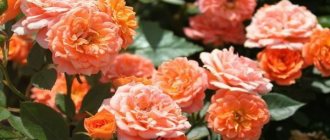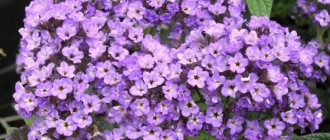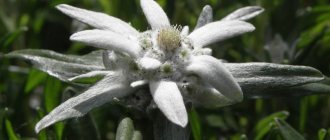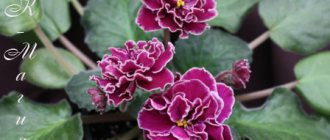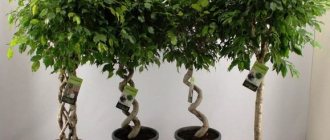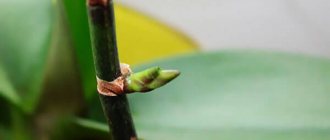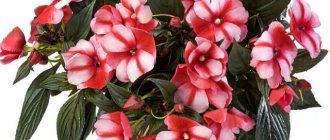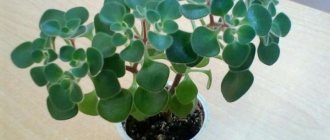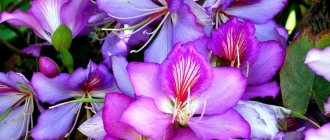In nature, edelweiss grows at an altitude of about 2 thousand meters above sea level, in the alpine and subalpine zones. This zone is characterized by high levels of ultraviolet radiation and low air humidity. That's why edelweiss trees have such thick silvery pubescence. It is not only beautiful, it protects the plant from excessive loss of moisture. By the way, by the degree of “pubescence” of a plant, one can tell how high above sea level it grew: the lower, the less pubescence, up to its complete loss.
- Edelweiss and Leontopodium: where did the name come from?
- Appearance
- Alpine edelweiss and features of its cultivation in the middle zone Reproduction of edelweiss Reproduction by dividing the bush
- Propagation by seeds
Edelweiss and Leontopodium: where did the name come from?
The scientific name Leontopodium consists of two Greek words: “leon” (λέων, leon) - lion and “podion” (ποδεών, podion) - paw, i.e. lion's paw . Where did this name come from? Everything is clear without words, just look at the fluffy edelweiss flower, so similar to the paw of a snow leopard.
And the name edelweiss itself is a combination of two German words “edel” - “noble” and “weiß” - “white”, i.e. noble white. And you can't argue with that either.
Edelweiss flower
By the way, in France, edelweiss is known as the Alpine star, and in Italy it is the silver flower of the rocks.
Appearance of edelweiss
More than 30 species are known, which in nature are distributed in the mountainous regions of Eurasia (mainly in Southeast Asia), excluding the Caucasus, Western Asia and South America.
All representatives are rhizomatous perennial or annual plants, from 10 to 30 cm in height. Inflorescences are small baskets, collected in capitate inflorescences, surrounded below by a rosette of pubescent leaves. The flowers themselves are very small, yellowish or white.
Himalayan edelweiss blooming.
Edelweiss blooms in summer: July - August.
alpine edelweiss (Guaphalium alpinum, Leontopodium alpinum) is mainly used . Several more species can be found in botanical gardens and private collections.
Alpine edelweiss and features of its cultivation in the middle zone
Alpine edelweiss naturally grows at high altitudes in the mountains, like all its relatives.
Alpine edelweiss is a small silvery bush, about 25-30 cm high, with branched stems and small gray leaves. It blooms in July-August, for 20-25 days.
Alpine edelweiss flowers
Externally, Alpine edelweiss can be quite different from each other. This is due, as mentioned above, to the height of their growth. To preserve the characteristics of the plant, it is better to propagate edelweiss vegetatively. Or use seeds only from trusted producers for sowing.
Detailed description of the plant
Many gardeners know well what an edelweiss flower looks like in its natural environment. Therefore, do not be afraid to grow it in your summer cottages. Taking a closer look at the plant, you can see that it consists of the following elements:
- Single erect shoots approximately 25 cm high.
- Basal rosette of lanceolate leaves lying on the soil.
- Delicate buds of white or yellow color, abundantly covered with silk hair.
Edelweiss blooms in the middle of summer, when the last echoes of low temperatures fade into oblivion. It decorates the flowerbed for about 20 days, just like the mountain slopes of the Alps in Switzerland. Its inflorescences consist of several original baskets in the form of twisted buds of white or yellow color. Around them are linear leaves covered with an abundance of delicate fibers. Thanks to this combination, an elaborate star is formed, typical of edelweiss.
The petals of the buds are also abundantly pubescent, so it seems that they are cast from wax. These miniature lumps seem to peek out from under the snow lying on the star-shaped leaf plates. Such beauty leaves no one indifferent, which is why many people like this mountain flower of love.
As a result of successful pollination, cylindrical achenes containing many seeds are formed on the peduncles. They can be used to propagate this wonderful flower.
Edelweiss propagation
Propagation of edelweiss by dividing the bush
It is best to divide edelweiss bushes in early spring or early autumn. There are no special secrets here, just carefully divide the bush and plant the divisions in the ground in a permanent place with a distance of at least 25 cm.
Edelweiss variegated, Edelweiss bicolor, Edelweiss bicolor (Leontopodium discolor) - bushes up to 30-35 cm tall. Flowers up to 4 cm in diameter.
Propagation of edelweiss by seeds
Alpine edelweiss seeds can be freely purchased online.
Method: sowing seedlings in seedling pots
Sow the seeds at the end of February - in March for seedlings in pots. Make soil for edelweiss seedlings from soil, perlite and sand in approximately equal proportions. Sow the seeds on the surface, lightly pressing them into the soil. Spray the seeds from above with a spray bottle and cover the crops with glass or film.
The seeds germinate quickly: within a week or two, shoots will appear. But then the edelweiss sprouts will develop quite slowly. Keep edelweiss seedlings in a bright but cool place.
The main thing in growing edelweiss seedlings is not to overwater or overdry.
In May, plant the seedlings in a permanent place. Edelweiss will bloom next season.
Method: sowing seedlings in large flower pots
Since edelweiss seedlings are very small and weak, the first year they can not be planted in the ground, but grown in pots until the end of summer, and in the fall the pots can be buried in the area. Once the edelweiss bush has reached a sufficient size, they can be planted in the garden in a permanent place, in spring or late summer.
Edelweiss alpine
If you choose the second path, then when sowing seeds, choose larger pots so that the plants are comfortable. In this case, you cannot sow edelweiss in small specialized pots for seedlings; their size will not be sufficient for plant growth throughout the season.
Method: direct sowing into the ground
And the third method of seed propagation of edelweiss is direct sowing into the ground. Edelweiss seeds are sown directly into the ground in May, shoots appear in June.
Application
When growing edelweiss, gardeners wonder what they use the crop for besides decoration. The culture is used in folk medicine, as well as in other areas.
At home
In everyday life, edelweiss is used as a material for making bouquets. Dried flowers retain their shape and decorative properties perfectly. This feature allows you to make winter bouquets from plants. Edelweiss is cultivated as a cosmetic product.
The plant is used in cosmetology, as a remedy for facial rashes. Edelweiss has hypoallergenic properties and is therefore included in baby care products. Edelweiss extract is found in shampoos that help fight dandruff, and also give hair shine and accelerate growth.
In medicine
Despite the fact that in traditional medicine edelweiss is not designated as a medicinal plant, many doctors know what the culture helps with. The juice of the culture has the following properties:
- restorative;
- healing;
- bactericidal;
- rejuvenating.
In addition, when used correctly, edelweiss helps fight cramps, relieves inflammation and tones the body. The flower makes it easier to cough up mucus. Leontopodium strengthens immune cells, due to which a person suffers less from colds.
In folk medicine
Traditional healers actively use edelweiss in the treatment of various pathologies. Culture is found in many recipes. Edelweiss is harvested during flowering, when the flower has the greatest amount of beneficial substances. The flowers are carefully cut and dried in an open space. After drying, the plants are stored in paper bags. Leontopodium retains its healing properties for 3 years.
Due to its medicinal properties, edelweiss is used in decoctions, infusions, and tinctures to improve human health. Based on the culture, anti-inflammatory decoctions are prepared that help with rheumatism, diseases of the respiratory system and heart. Some gardeners prepare creams and ointments with edelweiss that have a healing or pain-relieving effect.
Recipes
- a decoction to eliminate colds - to prepare it, add 1 tablespoon of dry herb to a glass of boiling water. The solution is boiled in a water bath for a quarter of an hour. The finished mixture is cooled to a comfortable temperature, filtered and drunk throughout the day. This decoction helps relieve cough and pneumonia.
- Cleanser - for the rejuvenating properties of the plant, a mixture of plants is used - edelweiss, rosemary and elecampane. All plants are dried and crushed, then mixed. 2 tablespoons of each flower are added to half a liter of vodka. The mixture is infused for 2 weeks, after which the tincture is filtered and used as a wiping lotion.
- Tonic collection - dried edelweiss herb is mixed with sage, eucalyptus and chamomile in equal parts. A tablespoon is poured into a glass of boiling water, then boiled for several minutes in a water bath. The strained decoction helps relieve fatigue, fear and nervousness.
- Lotion for dry skin - to eliminate dry skin, the lotion is prepared on the basis of dry white wine. 2 tablespoons of edelweiss are mixed with 0.7 liters of wine, then put on fire for 10 minutes. The resulting infusion is cooled and infused for 3 days. Wipe the skin with the resulting solution.
Conditions for growing edelweiss
For successful growth of edelweiss, it is necessary to comply with the plant requirements for growing conditions. When planting, just keep in mind what edelweiss likes and dislikes.
Containers with edelweiss bushes for planting in the garden
Edelweiss likes:
- Sunny location
- Dry, well-drained soil, enriched with lime, moderately fertile.
- The presence of fine crushed stone or coarse sand in the soil.
- Weeding, without loosening.
Edelweiss does not like:
- Shady location.
- It's hot.
- Dampness.
- Fertilizers! Edelweiss does not like either organic matter or mineral additives.
- Loosening the soil.
- Watering (except on very hot and dry summer days).
It is useful to mulch edelweiss trees for the winter. Severe frosts can damage the plant, but, as a rule, it recovers quickly.
In addition to alpine edelweiss, you can sometimes find and purchase for your collection such species as: Kuril, Siberian, pale yellow and edelweiss edelweiss. The differences in appearance between the species are small, and their growing conditions are the same.
Siberian edelweiss, or Pilibina (Leontopodium palibinianum, Leontopodium sibiricum) is similar to alpine edelweiss. But its bushes are larger, and its flowers, on the contrary, are smaller. Blooms June-September
Chemical composition
The edelweiss herb contains a large amount of minerals and vitamins. The composition of the plant is determined by the content of potassium, calcium and magnesium. The vitamin composition is due to ascorbic acid, vitamins A and K. The plant also contains flavonoids and tannins, tannins and phenols.
You might be interested in: Blackroot
Due to the content of useful substances in its composition, the plant is actively used in folk medicine. The culture is effective for treating diseases such as:
- gallbladder pathology;
- disorders of the heart and blood vessels;
- hypertonic disease;
- rheumatism;
- whooping cough.
The plant is actively used in cosmetology because it has anti-aging properties. The culture is added to various creams and cosmetics. Edelweiss contains no toxic substances, as well as poisonous and harmful components.
